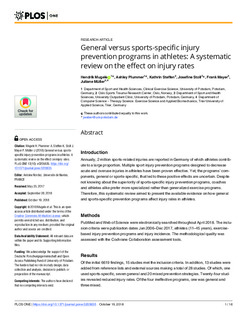| dc.contributor.author | Mugele, Hendrik | |
| dc.contributor.author | Plummer, Ashley | |
| dc.contributor.author | Steffen, Kathrin | |
| dc.contributor.author | Stoll, Josefine | |
| dc.contributor.author | Mayer, Frank | |
| dc.contributor.author | Müller, Juliane | |
| dc.date.accessioned | 2019-05-08T10:44:45Z | |
| dc.date.available | 2019-05-08T10:44:45Z | |
| dc.date.created | 2019-01-09T10:27:32Z | |
| dc.date.issued | 2018 | |
| dc.identifier.citation | PLoS ONE. 2018, 13, e0205635. | nb_NO |
| dc.identifier.issn | 1932-6203 | |
| dc.identifier.uri | http://hdl.handle.net/11250/2596959 | |
| dc.description | This is an open access article distributed under the terms of the Creative Commons Attribution License, which permits unrestricted use, distribution, and reproduction in any medium, provided the original author and source are credited. | nb_NO |
| dc.description.abstract | Introduction: Annually, 2 million sports-related injuries are reported in Germany of which athletes contribute to a large proportion. Multiple sport injury prevention programs designed to decrease acute and overuse injuries in athletes have been proven effective. Yet, the programs’ components, general or sports-specific, that led to these positive effects are uncertain. Despite not knowing about the superiority of sports-specific injury prevention programs, coaches and athletes alike prefer more specialized rather than generalized exercise programs. Therefore, this systematic review aimed to present the available evidence on how general and sports-specific prevention programs affect injury rates in athletes. Methods: PubMed and Web of Science were electronically searched throughout April 2018. The inclusion criteria were publication dates Jan 2006–Dec 2017, athletes (11–45 years), exercise-based injury prevention programs and injury incidence. The methodological quality was assessed with the Cochrane Collaboration assessment tools. Results: Of the initial 6619 findings, 15 studies met the inclusion criteria. In addition, 13 studies were added from reference lists and external sources making a total of 28 studies. Of which, one used sports-specific, seven general and 20 mixed prevention strategies. Twenty-four studies revealed reduced injury rates. Of the four ineffective programs, one was general and three mixed. Conclusion: The general and mixed programs positively affect injury rates. Sports-specific programs are uninvestigated and despite wide discussion regarding the definition, no consensus was reached. Defining such terminology and investigating the true effectiveness of such IPPs is a potential avenue for future research. | nb_NO |
| dc.language.iso | eng | nb_NO |
| dc.subject | sports and exercise medicine | nb_NO |
| dc.subject | sports | nb_NO |
| dc.subject | ankles | nb_NO |
| dc.subject | knees | nb_NO |
| dc.subject | systematic reviews | nb_NO |
| dc.subject | database searching | nb_NO |
| dc.subject | ligaments | nb_NO |
| dc.subject | traumatic injury | nb_NO |
| dc.title | General versus sports-specific injury prevention programs in athletes: A systematic review on the effect on injury rates | nb_NO |
| dc.type | Journal article | nb_NO |
| dc.type | Peer reviewed | nb_NO |
| dc.description.version | publishedVersion | nb_NO |
| dc.rights.holder | © 2018 Mugele et al. | nb_NO |
| dc.source.pagenumber | e0205635 | nb_NO |
| dc.source.volume | 13 | nb_NO |
| dc.source.journal | PLoS ONE | nb_NO |
| dc.source.issue | 10 | nb_NO |
| dc.identifier.doi | 10.1371/journal.pone.0205635 | |
| dc.identifier.cristin | 1652986 | |
| dc.description.localcode | Seksjon for idrettsmedisinske fag / Department of Sport Medicine | nb_NO |
| cristin.unitcode | 150,34,0,0 | |
| cristin.unitname | Seksjon for idrettsmedisinske fag | |
| cristin.ispublished | true | |
| cristin.fulltext | original | |
| cristin.qualitycode | 1 | |
